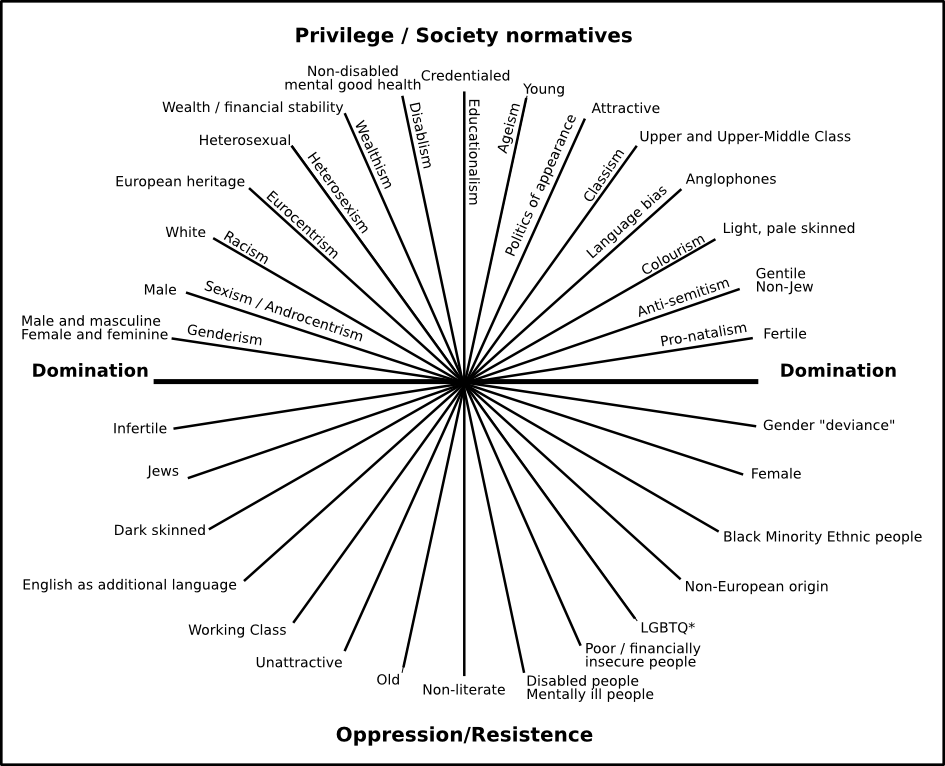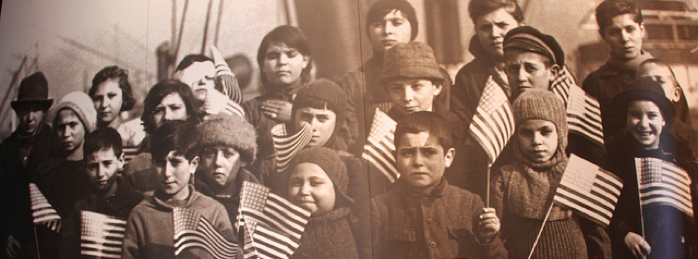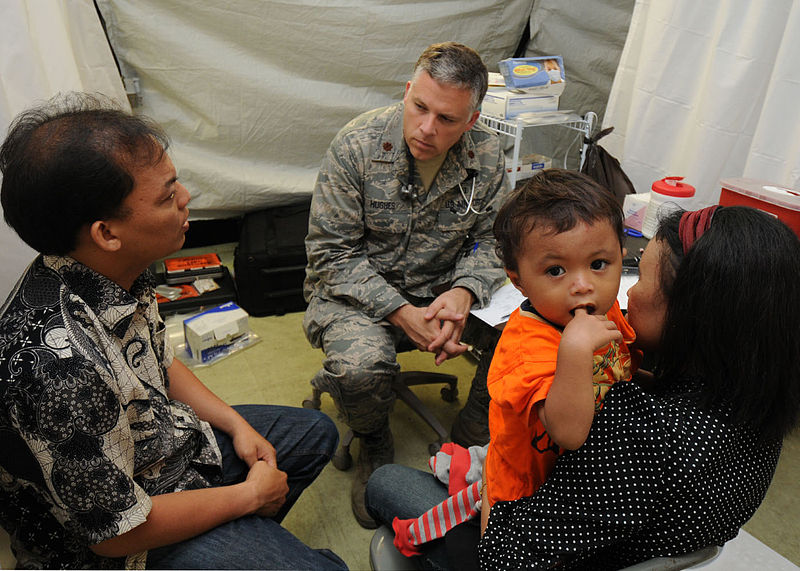3.3: Intersectionality
- Last updated
- Save as PDF
- Page ID
- 104046

- Erika Gutierrez, Janét Hund, Shaheen Johnson, Carlos Ramos, Lisette Rodriguez, & Joy Tsuhako
- Long Beach City College, Cerritos College, & Saddleback College via ASCCC Open Educational Resources Initiative (OERI)
Intersectionality and Stratification
Within intersectionality theory, an individual has multiple intersecting identities. These identities are informed by group memberships such as gender, class, race, sexuality, ethnicity, ability, religion, nativity, gender identity, and more (Case, 2013). Intersecting identities place an individual at a particular social location. Individuals may have similar experiences with other individuals within one community, such as similar experiences to others of their nation of origin, but their experiences may also be quite different depending on other identities they hold. For example, consider a dark-skinned, lesbian, middle class, female immigrant from Central America; all of her identities combine to create her unique experience which may vary significantly from other immigrants from Central America.

Class and Labor
The most critical step towards economic well-being is obtaining adequate employment. Immigrants account for more than 17% of the United States work force, although they make up only 13% of the population (Migration Policy Institute, 2013). The unemployment rate for foreign-born persons is currently 5.6%, while it is 6.3% for native-born persons (United States Bureau of Labor Statistics, 2015). Although immigrants have relatively high rates of labor force participation, the opportunities and benefits that are available to them depend on the level of employment they can obtain. We will address each in turn.

Low-skill labor force
Immigrants make up half of the low-skill labor force in the United States (United States Bureau of Labor Statistics, 2011). In 2005, it was estimated that undocumented immigrants make up 23% of the low-skill labor force (Capps, Fortuny, & Fix, 2007). Low-skilled immigrant workers tend to be overrepresented in certain industries, particularly those with lower wages. Table \(\PageIndex{3}\) displays the foreign-born workforce by occupation.
| Occupation | Share of Foreign-Born Workers in Occupation (%) | Share of Native-Born Workers in Occupation (%) |
|---|---|---|
| Management, professional, and related | 29.8 | 37.7 |
| Service | 25.1 | 17 |
| Sales and office | 17.1 | 25.6 |
| Production, transportation, and material moving | 15.2 | 11.6 |
|
Natural resources, construction, and maintenance |
12.9 | 8.1 |
Approximately 20% of immigrant workers are employed in construction, food service, and agriculture (Singer, 2012). More than half of all workers employed in private households are immigrants, and immigrants also represent 1/3 of the workers in the hospitality industry (Newbuger & Gryn, 2009). The majority of the positions in these industries are low-wage jobs.

Middle- and high-skill labor force
More educated and skilled immigrant workers can obtain jobs that are high paying and offer job stability such as those in healthcare, high-technology manufacturing, information technology, and life sciences. Immigrant workers are keeping pace with the native-born workforce in these high skill industries (Singer, 2012). As compared to their native-born peers, immigrants hold bachelors and graduate degrees at similar rates, 30% and 11% respectively (Singer, 2012).

Barriers to better employment
The largest barriers to higher-paying employment for immigrants are a lack of education and English-speaking ability. Approximately 29% of immigrant workers do not hold a high school diploma compared to only 7% of their native-born peers (Singer, 2012). Moreover, about 46% of immigrant workers would classify themselves as limited English proficient speakers (Capps, Fix, Passel, Ost, & Perez-Lopez, 2003). More than 62% of immigrant workers in low-wage jobs are limited English language speakers compared to only 2% of native-born workers in low-wage jobs (Capps, Fix, Passel, Ost, & Perez-Lopez, 2003). A study conducted by the Robert Wood Johnson Foundation (Garrett, 2006) found that it is extremely difficult for refugees to move from low-paying to better paying jobs after they have adjusted to living in the United States because many lack English language skills and education. It is difficult for immigrants to seek more education or training, due to the pressing need to work to provide for their families. Leaving the workforce to train may leave them financially vulnerable.
Immigrant workers who are middle-wage earners are still disadvantaged. In comparison to their native-born peers who earn a median income of $820 weekly, a full-time salaried immigrant worker earns $664 weekly (United States Bureau of Labor Statistics, 2015). Moreover, these workers earn 12% less in hourly wages than their native-born counterparts; this wage gap is 26% in California, a state with the largest immigrant workforce at 37% (Bohn & Schiff, 2011).
These wage disadvantages are partially due to employer discrimination. In 1996, the Illegal Immigration Reform and Immigrant Responsibility Act (IRCA) implemented additional restrictions on employment eligibility verification, including sanctions for employers who hired undocumented immigrants. Although it is illegal for an employer to discriminate based on national origin or citizenship status, many employers chose to avoid hiring individuals who appeared foreign, in order to avoid sanctions. A United States General Accounting Office report to Congress found that 19% of employers (approximately 891,000 employers) admitted to discriminating against people based on language, accent, appearance, or citizenship status because of fear of violating IRCA.
Immigrant workers also face high rates of wage and workplace violations. A study looking at workplace violations in three large metropolitan cities in the United States (Chicago, Los Angeles, and New York City) found that immigrant workers were twice as likely to experience a minimum wage violation than their native-born peers (Bernhardt, Milkman, Theodore, Heckathorn, Auer, DeFilippis, González, Narro, Perelshteyn, Polson, & Spiller, 2008). Another study conducted by Orrenius and Zavodny (2009) also found that immigrants are more likely to be employed in dangerous industries than their native-born peers, and they also experience more workplace injuries and fatalities. In these injuries, limited English skills are a contributing factor. These workers may be afraid to speak for themselves with their livelihood at stake and are left at the mercy of others. Immigrant workers are in dire need of representation, but infrequently have access to it. Only 10% of the immigrant workforce is represented by unions in contrast to 14 percent the native-born workforce (Batalova, 2011).
Lastly, as assessed and concluded by JooHee (2020), "I find that immigrants whose skin tone is darker are more penalized in the process of migration to the United States by experiencing steeper downward occupational mobility relative to those whose skin tone is lighter." While not all immigrants may need to contend with discrimination on the basis of legal status and/or language limitations, phenotype as an identifiable marker of race, impacts all immigrants because it is immediately visible/perceptible.
Healthcare and Mental Health
Although immigrants have high rates of labor force participation, they are less likely than native-born peers to have health insurance (Derose, Bahney, Lurie, & Escarce, 2009). There are few services in the United States that are as crucial and complex as the healthcare system, which continues to be a major indicator of socio-economic success. A person’s inability to access and utilize healthcare services gives a strong indication of critical unmet needs and barriers that impede the ability of successful integration and participation in society. Immigrants face substantial barriers to healthcare access, including restricted access to government based healthcare services, language difficulties, and cultural differences.

Reduced Use of Healthcare
Total health care expenditures are lower for immigrant adults than for their native-born peers (Derose et al., 2009). Additionally, immigrants are less likely to report a regular source or provider for health care, and report lower health care use than native-born peers (Derose et al., 2009). This means that overall, immigrants have less access to healthcare and less healthcare use than do most native-born individuals.
Undocumented immigrants have particularly low rates of health insurance and health care use (Ortega, Fang, Perez, Rizzo, Carter-Pokras, Wallace, & Gelberg, 2007). Undocumented Latinos/as have fewer physician visits annually than native born Latinos/as (Ortega et al., 2007). Undocumented immigrants are more likely than documented immigrants or native-born individuals to state that they have difficulty understanding their physicians or think they would get better care if they were a different race or ethnicity. Despite their low rates of use, immigrants are in need of healthcare. Children of immigrants are also more than twice as likely as children of natives to be in “fair” or “poor” health (Reardon-Anderson, Capps & Fix, 2002).
Legal Status Restricts Healthcare Benefit Eligibility
Immigration status is an important legal criterion that may hinder access to healthcare benefits. The Personal Responsibility and Work Opportunity Reconciliation Act (PRWORA), established in 1996, restricted Medicaid eligibility of immigrants. Immigrants cannot receive coverage, except in cases of medical emergencies, during their first five years in the country. States can choose to grant aid out of their own funds, but no federal welfare funds may be used for immigrant health care. The reform also stated that the eligibility of an immigrant for public services would be dependent on the income of the immigrant’s sponsor, who could be held financially liable for public benefits used by the immigrant. Finally, the Act required that states or local governments who fund benefits for undocumented immigrants take steps to identify their eligibility (Derose, Escarce, & Lurie, 2007). Hence, health benefits and insurance for most immigrants are highly dependent on eligibility through employment.
Mental Health
Families immigrate to the United States for various reasons. Some voluntary immigrants may choose to leave their country of origin in search of better opportunities, while others are forced to flee due to war, political oppression, or safety issues. Some families manage to stay together over the course of their journey, but many are divided or separated through the migration process. This is particularly true of refugee families whose migration is involuntary, hasty, and traumatic in nature (Rousseau, Mekki-Berrada, & Moreau, 2001). Refugees in particular may have survived traumatic events and violence including war, torture, multiple relocations, and temporary resettlements in refugee camps (Glick, 2010; Jamil, Hakim-Larson, Farrag, Kafaji, & Jamil, 2002; Keys & Kane, 2004; Steel, Chey, Silove, Marnane, Bryant, & Van Ommeren, 2009). The destructive nature of war “involves an entire reorganization of family and society around a long-lasting traumatic situation” (Rousseau et al., 2001, p. 1264) and individuals and families may continue to experience traumatic stress related to family left behind and stressful living conditions long after they have resettled.
When it comes to mental and physical health, refugees are a part of an especially vulnerable population. While some adjust to life in the United States without significant problems, studies have documented the negative impact of a trauma history on the psychological wellbeing of refugees (Birman & Tran, 2008; Keller, Lhewa, Rosenfeld, Sachs, Aladjem, Cohen, Smith, & Porterfield, K, 2006). Pre-migration experiences may precipitate refugee mental health concerns, particularly in the early stages of resettlement (Beiser, 2006; Birman & Tran, 2008). These experiences may include witnessing and experiencing violence, fleeing from a family home located in a city or village that is being destroyed, and walking to find refuge and safety for days or weeks with limited food, water, and resources. Post-migration conditions, such as adapting to living in an overcrowded refugee camp or trying to rebuild life in a foreign country, as well as structural stressors, such as going through the legal process of obtaining asylum or legal documentation, may also precipitate a cascade of individual mental health and family relational issues. The pre- and post-migration experiences and stressors of refugees may compound and create a “cumulative effect on their ability to cope” (Lacroix & Sabbah, 2011). Spending weeks, months, or even years managing stressful and traumatic experiences may weaken an individual or family’s ability to cope with continued change and the multiple stressors of resettlement.
While it is reported that refugees are at risk for higher rates of psychiatric disorders such as posttraumatic stress disorder (PTSD), depression, anxiety, complicated grief, psychosis, and suicide (Akinsulure-Smith & O’Hara, 2012; Birman & Tran, 2008; Jamil et al., 2002; Jensen, 1996; Kandula, Kersey, & Lurie, 2004; Steel et al., 2009), immigrants are also at risk for these mental health complications, especially if they have been exposed to multiple traumatic events. However, when working with immigrants and refugees, it is important to remember that one cannot assume that all members of an affected population are psychologically traumatized and will have the same mental health symptoms (Shannon, Wieling, Simmelink, & Becher, 2014; Silove, 1999). Further, mental health symptomatology is expressed in a variety of culturally sanctioned ways. For example, somatic complaints such as headaches, dizziness, palpitations, and fatigue might be a way to avoid stigma and shame often associated with admitting to mental health problems (Shannon, Wieling, Im, Becher, & Simmelink, 2014).
We know that the mental health of an individual does not exist in isolation; the experiences of one person in a family or community affect others. Unfortunately, the majority of the literature about immigrant and refugee mental health focuses on mental health as an individual process; the systemic ramifications are understudied and underrepresented in academic literature (Landau, Mittal, & Wieling, 2008; Nickerson, Bryant, Brooks, Steel, Silove, & Chen, 2011).
Contributors and Attributions
- Gutierrez, Erika. (Santiago Canyon College)
- Ramos, Carlos. (Long Beach City College)
- Immigrant and Refugee Families (Ballard, Wieling, and Solheim) (CC BY-NC 4.0)
Works Cited
- Akinsulure-Smith, A.M., & O’Hara, M. (2012). Working with forced migrants: therapeutic issues and considerations for mental health counselors. Journal of Mental Health Counseling 34(1), 38-55.
- Anthias, F. (2001). The concept of social division and theorising social stratification: looking at ethnicity and class. Sociology 35(4), 835-854.
- Anthias, F. & Yuval-Davis, N. (2005). Racialized Boundaries: Race, Nation, Gender, Colour and Class and the Anti-racist Struggle. New York, NY: Routledge.
- Batalova, J. (2011). Foreign-born wage and salary workers in the U.S. labor force and unions. Migration Policy institute.
- Beiser, M. (2006). Longitudinal research to promote effective refugee resettlement. Transcultural Psychiatry 43:1, 56-71.
- Berg, J.A. (2010). Race, class, gender, and social space: using an intersectional approach to study immigration attitudes. The Sociological Quarterly 51, 278–302.
- Bernhardt, A., Milkman, R., Theodore, N., Heckathorn, D., Auer, M., DeFilippis, J., González, A.Z., Narro, V., Perelshteyn, J., Polson, D., & Spiller, M. (2009). Broken laws, unprotected workers. National Employment Law Project.
- Birman, D. & Tran, N. (2008). Psychological distress and adjustment of Vietnamese refugees in the united states: association with pre- and post-migration factors. American Journal of Orthopsychiatry 78(1), 109-120.
- Bohn, S. & Schiff, E. (2011). Immigrants and the labor market. Public Policy Institute of California.
- Bradley, H. (1996). Fractured Identities: Changing Patterns of Inequality. Cambridge, MA: Polity Press.
- Capps, R., Fix, M., Passel, J.S., Ost, J., & Perez-Lopez, D. (2003). A profile of the low-wage immigrant workforce. The Urban Institute.
- Case, K. (2013). Deconstructing Privilege: Teaching and Learning as Allies in the Classroom. New York, NY: Routledge.
- Cialdini, R.B., & Trost, M.R. (1998). Social influence: social norms, conformity, and compliance. In D.T. Gilbert, S.T. Fiske, G. Lindzey (Eds), The Handbook of Social Psychology. 4th ed, p. 151–192. Boston, MA: McGraw-Hill.
- Cialdini, R.B. (2001). Influence: Science and Practice. 4th ed. Boston, MA: Allyn & Bacon.
- Cole, E.R. (2009). Intersectionality and research in psychology. American Psychologist 64, 170–180.
- Crenshaw, K. (1989). Demarginalizing the intersection of race and sex: a Black feminist critique of antidiscrimination doctrine, feminist theory and antiracial politics. The University of Chicago Legal Forum 140, 139-167.
- Derose, K.P., Escarce, J.J., & Lurie, N. (2007). Immigrants and health care: sources of vulnerability. Health Affairs 26(5), 1258-1268.
- Derose, K.P., Bahney, B.W., Lurie, N., & Escarce, J.J. (2009). Immigrants and health care access, quality, and cost. Medical Care Research and Review 66(4), 355-408.
- Farver, J.A.M., Narang, S.K., & Bhadha, B.R. (2002). East meets west: ethnic identity, acculturation, and conflict in Asian Indian families. Journal of Family Psychology 16(3), 338-350.
- Glick, J. (2010). Connecting complex processes: a decade of research on immigrant families. Journal of Marriage and Family 72:3, 498-515.
- Gottfried, H. (2000). Compromising positions: emergent neo-fordisms and embedded gender contracts. The British Journal of Sociology 51:2, 235-259.
- Jamil, H., Hakim-Larson, J., Farrag, M., Kafaji, T., & Jamil, L. (2002). A retrospective study of Arab American mental health clients: Trauma and the Iraqi refugees. American Journal of Orthopsychiatry 72(3), 355-361.
- Jensen, S.B. (1996). Mental health under war conditions during the 1991–1995 war in the former Yugoslavia. World Health Statistics Quarterly 49, 213–217.
- JooHee, Han. (2020). Does skin tone matter? immigrant mobility in the U.S. labor market. Demography 57:2, 705-726.
- Kandula, N., Kersey, M., & Lurie, N. (2004). Assuring the health of immigrants: what the leading health indicators tell us. Annual Review Public Health 25, 357-376.
- Keller, A., Lhewa, D., Rosenfeld, B., Sachs, E., Aladjem, A., Cohen, I., Smith, H., & Porterfield, K. (2006). Traumatic experiences and psychological distress in an urban refugee population seeking treatment services. Journal of Nervous and Mental Disease 194:3, 188-194.
- Keys, E. & Kane, C. (2004). Belonging and adapting: mental health of Bosnian refugees living in the united states. Issues in Mental Health Nursing 25, 809-831.
- Lacroix, M. & Sabbath, C. (2011). Posttraumatic psychological distress and resettlement: the need for a different practice in assisting refugee families. Journal of Family Social Work 14, 43-53.
- Landau, J., Mittal, M., & Wieling, E. (2008). Linking human systems: strengthening individuals, families, and communities in the wake of mass trauma. Journal of Marital and Family Therapy 34(2), 193-209.
- Migration Policy Institute. (2010). Immigrant share of the U.S. population and civilian labor force, 1980-present.
- Modood, T., Berthoud, R., Lakey, J., Nazroo, J., Smith, P., Virdee, S., & Beishon, S. (1997). Ethnic Minorities in Britain: Diversity and Disadvantage, No. 843. London, UK: Policy Studies Institute.
- Nam, Y., Lee, E.J., Huang, J., & Kimm J. (2015). Financial capability, asset ownership, and later-age immigration: evidence from a sample of low-income older Asian immigrants. Journal of Gerontology and Social Work 58(2), 114-27.
- Newburger, E. & Gryn, T. (2009). The foreign-born labor force in the United States: 2007. United States Census Bureau.
- Nickerson, A., Bryant, R.A., Brooks, R., Steel, Z., Silove, D., & Chen, J. (2011). The familial influence of loss and trauma on refugee mental health: A multilevel path analysis. Journal of Traumatic Stress 24(1), 25–33.
- Orrenius, P.M. & Zavodny, M. (2009). Do immigrants work in riskier jobs? Demography 46(3), 535-551.
- Ortega, A.N., Fang, H., Perez, V.H., Rizzo, J.A., Carter-Pokras, O., Wallace, S.P., & Gelberg, L. (2007). Health care access, use of services, and experiences among undocumented Mexicans and other Latinos. Archives of Internal Medicine 167(21), 2354-2360.
- Phinney, J.S., Horenczyk, G., Liebkind, K., & Vedder, P. (2001). Ethnic identity, immigration, and well‐being: An interactional perspective. Journal of Social Issues 57(3), 493-510.
- Pollert, A. (1996). Gender and class revisited; or, the poverty of patriarchy. Sociology 30(4), 639-659.
- Reardon-Anderson, J., Capps, R., & Fix, M.E. (2002). The health and well-being of children in immigrant families. The Urban Institute.
- Rousseau, C., Mekki-Berrada, A., & Moreau, B. (2001). Trauma and extended separation from family among Latin American and African refugees in Monteal. Psychiatry Journal 64(1), 40-59.
- Rumbaut, R.G. (1994). The crucible within: ethnic identity, self-esteem, and segmented assimilation among children of immigrants. International Migration Review 28(4), 748-794.
- Sakamoto, I. (2007). A critical examination of immigrant acculturation: toward an anti-oppressive social work model with immigrant adults in a pluralistic society. British Journal of Social Work 37, 515–535.
- Shannon, P., Wieling, E., Im, H., Becher, E., & Simmelink, J. (2014). Beyond stigma: barriers to discussing mental health in refugee populations. Journal of Loss and Trauma 20:3, 281-296.
- Shannon, P., Wieling, E., Simmelink, J., & Becher, E. (2014). Exploring the mental health effects of political trauma with newly arrived refugees. Qualitative Health Research 25:4, 443-457.
- Shields, S.A. (2008). Gender: an intersectionality perspective. Sex Roles 59, 301–311.
- Silove, D. (1999). The psychosocial effects of torture, mass human rights violations and refugee trauma: towards an integrated conceptual framework. Journal of Nervous & Mental Disease 187, 200-207.
- Steel, Z., Chey, T., Silove, D., Marnane, C., Bryant, R.A., & Van Ommeren, M. (2009). Association of torture and other potentially traumatic events with mental health outcomes among populations exposed to mass conflict and displacement: systematic review and meta-analysis. Journal of the American Medical Association 302, 537–549.
- United States General Accounting Office. (1990). Immigration reform: Employer sanctions and the question of discrimination.
- United States Bureau of Labor Statistics. (2015). Foreign-born workers labor force characteristics.
- United States Bureau of Labor Statistics. (2013). National occupational employment and wage estimates united states.
- Weber, L. (1998). A conceptual framework for understanding race, class, gender, and sexuality. Psychology of Women Quarterly 22:1, 13-32.

